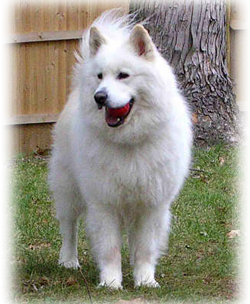The Bark Stops Here
One of the most frequent complaints we hear from owners, both our adopters and owners looking to give up their dog, is that the dog barks. Vocalizing, whether it’s barking or one of the other sounds our dogs make, is a characteristic common not only to Samoyeds, but also to the other Northern breeds, so some barking should be expected. After all, if we’d wanted a dog that never barked, we’d have adopted a Basenji, right?
Seriously, though, uncontrolled barking can get out of hand & be annoying to you, your family, and your neighbors. If you are willing to invest a little time & energy into teaching your dog not to bark, owning a Samoyed doesn’t mean you have to live with incessant barking.
When your dog is barking & barking & barking, it’s a natural instinct to roar at your dog, “Fido, Shut up!” However, most of us have tried this and realize that it’s not effective. From your dog’s way of thinking, your yelling is your pathetic attempt at barking, so he believes you are trying to join in the fun. Not exactly the effect you were going for!
So, how do you stop your dog from barking? The first step is to figure out why your dog is barking. Dogs bark for different reasons: excitement,
anxiety/fear, excess energy, boredom, territorial reasons, etc. Determining what triggers your dog’s barking will help you figure out how
to best solve the problem. There are many ‘negative’ ways to deal with barking, but I always prefer to use positive methods. In my experience,
they work better/faster, and it helps keep the owner-dog relationship intact. Given that, some positive suggestions are listed below:
LET SLEEPING DOGS LIE – There is a saying among trainers that “A tired dog is a good dog”. Exercise is probably the easiest thing you can do that will make the fastest difference. Regardless of what might be triggering his barking, if your dog has gotten sufficient exercise, he’ll be too tired to bark; after all, a sleeping dog isn’t barking! Take your dog for a run, throw the ball for him, take him to a dog park, enroll him in agility classes, teach him some new tricks, etc. Increase his exercise/activity and you’re likely to solve most of the problem right there.
ACCENTUATE THE POSITIVE – Most of us get upset when our dogs are barking, but how many of us remember to praise/reward them when they are being quiet? Unfortunately, not many of us & that’s part of the problem. Start keeping treats in your pockets or stashed in various rooms of the house (out of Fido’s reach of course!) Then, when Fido is lying quietly, calmly tell him he’s a good boy (or say “Good Quiet”), slip him a treat, and go on with whatever you were doing. Do this every once in a while & your dog will soon realize that lying quietly is a way he can earn treats.
The flip side to this is to ignore your dog when he’s barking. Say nothing to him, turn your back, and/or walk away. In her book Culture Clash, the noted behaviorist Jean Donaldson states that ‘dogs do what works’. If barking gets them the desired effect (your attention, for instance), the dog will repeat this behavior. If on the other hand, barking loses its effectiveness, your dog will look for some other way to get your attention.
RIGHT ON CUE – Another way to deal with barking seems counter-intuitive at first blush — teach the dog to bark on cue/command. This works in 2 ways: first, by rewarding barking when you ask for it (and only then), your dog is less likely to bark on his own when he won’t get rewarded. Secondly, when you teach your dog to bark, you can teach him “Quiet” at the same time.
 To do this, find something that usually makes your dog bark. A ringing doorbell is a good bet. Have an assistant stand outside the door, waiting. Tell your dog to speak (or whatever word you want to use) & then have your assistant ring the doorbell. When the dog starts barking, tell him “Good speak! Good dog!”, but before you give him a treat, tell him “Quiet”. If necessary, wiggle the treat under his nose – he can’t sniff and bark at the same time, so he will stop barking to sniff the treat. That’s when you tell him “Good Quiet” (or whatever word you plan to use). Since he always gets rewarded during the “Quiet” part of the training exercise, you are actually reinforcing that he has to stop barking to get the treat.
To do this, find something that usually makes your dog bark. A ringing doorbell is a good bet. Have an assistant stand outside the door, waiting. Tell your dog to speak (or whatever word you want to use) & then have your assistant ring the doorbell. When the dog starts barking, tell him “Good speak! Good dog!”, but before you give him a treat, tell him “Quiet”. If necessary, wiggle the treat under his nose – he can’t sniff and bark at the same time, so he will stop barking to sniff the treat. That’s when you tell him “Good Quiet” (or whatever word you plan to use). Since he always gets rewarded during the “Quiet” part of the training exercise, you are actually reinforcing that he has to stop barking to get the treat.
WITH A WOO-WOO HERE AND A WOO-WOO THERE – Since Samoyeds are known for more sounds than just barking, another option for dealing with a barker is to reward them for other sounds that aren’t as harsh on the ears. For instance, I happen to love the “aroo” or “woo” sounds that my dogs make. When they bark, I ignore them, but if they aroo or woo, they get petted, praised, and treated. With consistency, they have realized that wooing is much more effective for them and they are much more likely to try that than to bark if they want my attention.
FIND AN ALTERNATIVE – Teach your dog an alternative, mutually exclusive behavior for those circumstances where he currently barks. For instance, does your dog bark whenever someone comes to the door? Instead of letting him rush to the door barking, why not teach him that when he hears the doorbell, his job is to go to his toy basket and get a toy? Not only will this give you time to let your guest in while he’s off getting a toy, but he also won’t be able to deafen you & your guests when he has a ball or stuffy in his mouth.
THAT’S THE TICKET – If all else fails, make barking the ticket for something they don’t want. My dogs love to be outside in cool weather and they can be when I am home. This, however, is conditional on their not barking. If they bark, they have to come inside. This prevents them from annoying my neighbors & it also teaches them that barking equals getting something they’d rather not have. Based on this, they quickly realized that barking is not a good thing to do. Your dogs will too!
by Ellen Engle, MidAtlantic Samoyed Rescue
(Reprinted with permission. No reproductions of this article allowed without author permission.)

